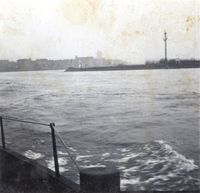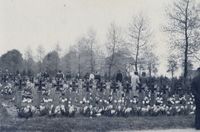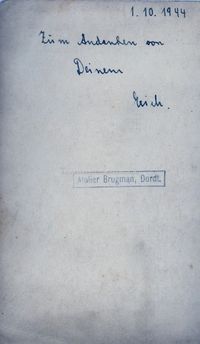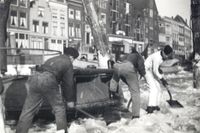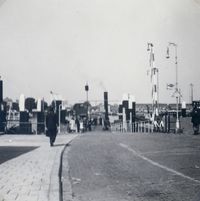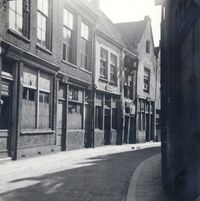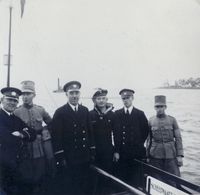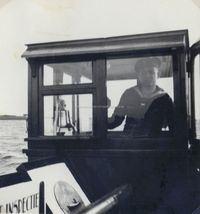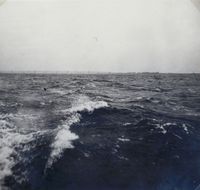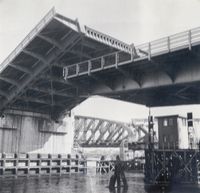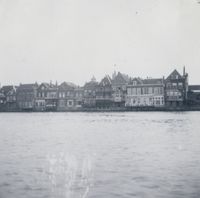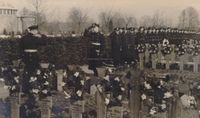The Kriegsmarine in Dordrecht.
During the Second World War, Dordrecht was an important city for the German army. The Germans cleverly utilized the existing infrastructure of the city. Schools were often used as barracks or quarters, and hospitals were also utilized. The city, with its many houses, provided space for the numerous German soldiers serving in or around the city. The German military was therefore not a strange phenomenon to the people of Dordrecht. The Kriegsmarine was no exception. The many ports in the city with access to inland waterways made Dordrecht an excellent base for supply ships of the Kriegsmarine. As the photographs below clearly show, at least the Nieuwe Haven in Dordrecht was significant.
Below, you can see a number of photos of Kriegsmarine ships on the Oude Maas near Dordrecht. The second photo was presumably taken further away. The third photo was taken in the Nieuwe Haven, with the Lange IJzeren brug (Long Iron Bridge) prominently featured, which holds significance for every resident of Dordrecht. The fourth photo shows a German Kriegsmarine soldier on guard duty at Venloostraat.
The next two photos were also taken in the Nieuwe Haven. An interesting detail in the first photo is that both the Huis van Gein and the current Museum 1940-1945 are clearly visible in the background. The second photo shows a glimpse of the fence to the right of the museum. The following two photos were taken from a ship. One on the Hollands Diep near the Moerdijk bridges, and the other on the Noord river close to the Oude Maas. The last photo captures a beautiful part of Dordrecht.
The following photo series was taken at the General Cemetery in Dordrecht. They will also be posted on that page. The first photo is presumably taken in the old chapel. Kriegsmarine soldiers are standing next to the coffin, presumably of a fallen comrade. However, it cannot be ruled out that the soldier died in an accident. The next two photos show the funeral itself. The crosses in the foreground still display fallen soldiers from May1940. The remaining three photos are of the German graves, also at the General Cemetery in Dordrecht. In the last photo, a residential house on the former Achterweg can be seen, which is now the Nieuweweg. It is most likely the current number 82 or 84.
The photos below are portrait photos of German Kriegsmarine soldiers. The photos were taken at various photo studios in Dordrecht. Many Dutch soldiers had their pictures taken there, and when the German occupiers came to Dordrecht, many German soldiers also had themselves photographed at one of the several Dordrecht photo studios during the war. These two German Kriegsmarine soldiers had their photos taken - one at Albertus Fröhling's studio on the Spuiweg 21, and the other at the Brugman photo studio on the Voorstraat 102.
The photos below are mostly pictures of the historic city center in Dordrecht. In this case, most of the photos were taken in the Nieuwe Haven. The first photo shows Huize Paul Kooiman on the Nieuwe Haven. Apparently, it was used by the Kriegsmarine during the war. The second photo was taken at approximately the same level. Kriegsmarine soldiers are playing with a dog, while a Dordrecht civilian watches in the background. The following photo was taken in winter, a bit further down from Huize Paul Kooiman. From the perspective of the photo, the soldiers appear to be standing on a frozen Nieuwe Haven, attempting to clear ice around a ship. The next photo shows a Kriegsmarine ship in the Nieuwe Haven, with a Kriegsmarine soldier posing next to the flagpole. Approximately to the right of the ship, you can see the distinctive white building at the Knolhaven. Next, there's another Kriegsmarine shot from a different perspective of the Nieuwe Haven. On the left, you can still see part of the Kuipershaven. The last photo is a beautiful shot from the water, with the Grote Kerk (Great Church) prominent in the frame. On the left is the Hooikade, and on the right is the corner of Buiten-Kalkhaven/Bomkade.
Kriegsmarine photo album. Below you will find the remaining portion of a photo album belonging to a German Kriegsmarine soldier. The album is no longer complete, but the photos are still in place. Most of the photos were taken in Dordrecht and depict various scenes. There are military-related photos as well as many atmospheric images of Dordrecht. These photos indicate that the creator had great appreciation for the city of Dordrecht, as the album is filled with ordinary scenes of the city and its surroundings. The album does not have any specific dates, but it is presumed that these photos were taken shortly after May 1940. Some photos, showing war damage, suggest that most of the photos were likely taken between May 1940 and June 1940, at least until August 1940.
One of the photos clearly shows that this Kriegsmarine soldier was quartered in a house on the Dokweg. In one photo, it is still clearly visible that this is the current number 17, with a Reichskriegsfahne (Nazi flag) hanging above the door. Another photo shows a Reichskriegsfahne hanging at the back of the corner house. Yet another photo shows a Kriegsmarine officer in the doorway of number 1, which is the current number 7, the house on the corner. It is possible that the entire row of houses was used by the Kriegsmarine. It cannot be determined with certainty which Kriegsmarine unit is involved here, but it is likely a unit belonging to the Hafenschutz-Flottille Südholland.
Some photos also show requisitioned ships. Firstly, a Dutch minesweeper named Hr. Ms. Abraham van der Hulst (II). It was a minesweeper in the Jan van Amstel class and the second ship with that name. The ship was being built at the P. Smit shipyard in Rotterdam and was not yet completed during the German invasion. The Germans requisitioned the ship and completed its construction. It was shipped to Emden on August 30, where it received the name M552. After December 1940, the ship was converted into a torpedo workshop ship. In August 1944, it was assigned to the 27th U-Flotilla in Gotenhafen, where U-boat crews were trained. The ship was found after the Second World War and handed over to the Dutch Navy.
The second ship is the Irene Holland. This ship was requisitioned by the Kriegsmarine Dienststelle Rotterdam in August 1940, to be used as a transport ship for Operation Seelöwe (the planned invasion of England). When this operation was canceled, it was converted into a Kanalinselversorger to supply the German-occupied English Channel Islands. In June 1944, the ship ran aground during an Allied attack and was also damaged by a bomb. In 1945, the ship was towed to Amsterdam, where it was found to be irreparable without enormous costs. As a result, the ship was scrapped.
One of the other requisitioned ships seen in the album on page six is the Batavier V (II). The ship was requisitioned by the Kriegsmarine in Rotterdam. Although initially used as an accommodation ship, it was later used for supplying the British Channel Islands. On November 3, 1941, the ship was torpedoed by a British torpedo boat, resulting in 13 casualties.
The second ship photographed on this album page is the Batavier III. This ship was already requisitioned by the Kriegsmarine on May 27, 1940, and put to use as an accommodation ship for the crews of German torpedo boats in Waalhaven. On January 1, it was transferred to F. Laeisz in Hamburg and used as a Sicherheitsschiff. On October 15, 1942, while sailing under the German flag to Norway, the ship struck a mine in the Kattegat and sank, resulting in the loss of all crew members.
When you click on the photos, you can view enlarged versions with any accompanying text and explanations.
The photos below show Kriegsmarine military personnel paying their last respects to fallen comrades. The photos were taken on March 15, 1942, during a commemoration where wreaths were laid for the fallen of the Flussräumflottille Niederlande. The officer on the left in photo 23 is Mr. Emmerich Schrittwieser. He served as the Flottilenchef between January 1941 and September 1944. The wreaths are clearly visible on the crosses. The photos were taken at the German Ehrfriedhof (honorary cemetery) at the former General Cemetery in Dordrecht.
The two photos below were taken in the harbor of Werf de Biesbosch. The photos were captured during one of the war winters between 1940 and 1945. In the first photo, there appears to be a patrol boat behind the German soldier. In the background, you can just see the chimney of Werf de Biesbosch.
Unfortunately, I have been unable to find much information thus far about the Kriegsmarine in Dordrecht. I would greatly appreciate any additional information, especially regarding the barracks locations and department office locations. It is highly likely that the latter was situated in the Nieuwe Haven. If you have further information, please don't hesitate to email: info@dordrechtindeoorlog.nl.
©2017-2025 :Https://www.Dordrechtindeoorlog.nl: ( There is a copyright on the content of this website. This content is not to be shared, duplicated or published withouth the explicit permission of the author of this website. If you have any requests you can email to: Info@Dordrechtindeoorlog.nl or look on : www.dordrechtindeoorlog.nl/termsofuseforthecontentonthiswebsite.
*1 Source: www.lexikon-der-wehrmacht.de/Hafenschutzflotieljen-südHolland
*2 Source: www.wikiwand.com/AbrahamvanHulst
*3 Source: www.marhisdata.nl/IreneHolland
*4 Source: www.maritiemdigitaal.nl/BatavierV
*5 Source: www.marhisdata.nl/BatavierIII







